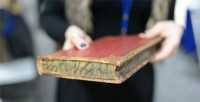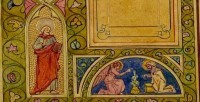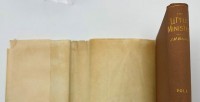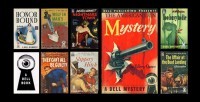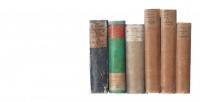The ABAA Gender Equity Initiative Committee is proud to announce the second round of the ABAA Mentorship Program. In an effort to further the Association's mission, the mentorship program builds relationships between ABAA dealers and early-career booksellers, provides professional development opportunities for prospective ABAA members, and creates a recruitment pipeline that increases the number and diversity of qualified applicants to the ABAA. Apply as a Mentor (ABAA Members only) Apply as a Mentee During the year-long mentorship period, with support from ABAA Headquarters, mentors and mentees meet monthly to discuss aspects of their individual businesses and the trade as a whole. Knowing that “fit” is key to a successful mentorship, ABAA Headquarters and the Gender Equity Initiative Committee carefully match mentors to mentees, taking into consideration special requests, areas of focus, and business models. Location may also be a factor, but with the availability of technology like Zoom, need not be a requirement. ABAA Headquarters will be available throughout the entire process, from applications to mentorship pairings through the completion of the program, to address any questions or concerns that may arise. More information including a full list of requirements for mentee and mentor applications can be found here... Please feel free to pass this opportunity along to employees, colleagues, or others who may be interested. Don't hesitate to reach out to Xin Yi Zhao, t... [more 2023-2024 ABAA Gender Equity Initiative Mentorship Program]
On Collecting Books
Recently, I got the opportunity to contribute a short article about the multi-talented architect, engraver, collector, writer, and naturalist Simon Schijnvoet (1652-1727) to the website of the Panpoëticon Batavûm (in Dutch). Schijnvoet not only was a moralistic and witty writer with great knowledge of history and natural philosophy, but he also designed the cabinet called the Panpoëticon Batavûm. So what is the Panpoëticon Batavûm? Many people know the most famous painters from the Dutch Republic, for instance Rembrandt and Vermeer. Besides that, however, around 1700, the painter and engraver Arnoud van Halen (1673-1732) thought that Netherlands' most famous poets and writers also deserved a place of honor. Therefore, he decided to initiate a cabinet in which these writers could be united, and he painted their portraits encasing them with list in the form of a golden laurel. The collection was very progressive for its time, also containing portraits of female and Flemish writers. Even decades after Van Halen's death, his successors kept organising elections to add more authors to the growing collection. In the end it contained over 350 portraits. Unfortunately, in 1807 a catastrophe happened: close to the room in which the Panpoëticon was housed in Leiden, a ship full of gunpowder exploded, ruining a large part of the town. Although the Panpoëticon survived the disaster, it was severely damaged. The explosion financially ruined its owners, so there was no money to res... [more Simon Schijnvoet in the Panpoëticon Batavûm]
This fascinating blog post about the history of vellum and parchment is written by Richard Norman, an experienced British bookbinder now living in France, where he runs Eden Wookshops with his wife and fellow bookbinder, Margaret, specializing in Family Bibles and liturgical books. The article originally appeared on www.edenworkshops.com, and is reprinted below with the author's permission. --Editor According to the Roman Varro and Pliny's Natural History, vellum and parchment were invented under the patronage of Eumenes of Pergamum, as a substitute for papyrus, which was temporarily not being exported from Alexandria, its only source. Herodotus mentions writing on skins as common in his time, the 5th century BC; and in his Histories (v.58) he states that the Ionians of Asia Minor had been accustomed to give the name of skins (diphtherai) to books; this word was adapted by Hellenized Jews to describe scrolls. Parchment (pergamenum in Latin), however, derives its name from Pergamon, the city where it was perfected (via the French parchemin). In the 2nd century B.C. a great library was set up in Pergamon that rivalled the famous Library of Alexandria. As prices rose for papyrus and the reed used for making it was over-harvested towards local extinction in the two nomes of the Nile delta that produced it, Pergamon adapted by increasing use of vellum and parchment. Writing on prepared animal skins had a long history, however. Some Egyptian Fourth Dynasty texts were written on vel... [more The History Of Vellum And Parchment]
I would like to record any three-deckers with surviving dust-jackets. I have one, and have heard of another, but there probably aren't many more than that. Three-Decker under Canvas. Three-Decker under Paper. A Thomas Hardy three-decker of unknown title is reported to retain remnants of jackets printed with rules and lettering. Does anyone know what title this is, and where it is today? My own three-decker is J. M. Barrie's The Little Minister (London, Paris and Melbourne: Cassell & Co., 1891) in the publisher's fine-ribbed cloth with plain white wove tissue jackets. This copy, described as the finest example extant, sold for $1,100 in 1938, quite a sum during the Great Depression. The plain jackets are definitely original: they exactly match the plain white tissue jacket on another Cassell novel, Robert Louis Stevenson's and Lloyd Osbourne's The Wrecker (1892), whose jacket was even cut short in the same way as the Barrie jackets, a fairly common occurrence then. And on both titles, the jackets have one flap wider than the other, again a common occurrence, at least on British jackets. And another Stevenson novel published by Cassell, Catriona (1893), also has the same white jacket. The uniform paper, cut and fold of all these jackets and the flawless condition of the bindings on three Cassell novels from 1891-92-93 is ample proof that the plain jackets are original. Someone, perhaps a bindery or bookstore clerk, put graphite on The Wrecker jacket to make the title stand out;... [more Jacketed Three-Deckers]
We asked the winners of the 2022 National Collegiate Book Collecting Contest about their collections, and learned about the importance of physical media during the Covid pandemic! First Prize Daria Rose Evdokimova (Harvard University): "Ardis Publishers and the Immigrant Identity." ABAA: Could you give us a brief description of your collection? DRE: My collection focuses on the publishing house Ardis Publishers, the first (and only) US-based publishing house which focused on Russian and Soviet literature. More specifically the majority of my collection consists of Ardis editions of works by Vladimir Nabokov and Joseph Brodsky. Both of these authors were born in Saint Petersburg and eventually immigrated to the US for political reasons. As someone who was exiled from Russia for political reasons as well, I feel a very personal connection to both of these authors. Like them I am also using the acts of reading and writing as attempts to construct a new life in the US. Books printed by Ardis Publishers are a fundamental part of that journey. Frequently immigrants feel that the narratives of their lives become somewhat disjoined, there's a before and after, two islands separated by different languages and cultures. Ardis books were published in the US, by a wife and husband team of American academics, and provided the only outlet for Soviet writers who couldn't be published at home. So for me these books provide the necessary bridge that helps connect two parts of my identity – ... [more Meet the 2022 NCBCC Winners]
One phrase you might hear at a rare-book fair is mapbacks. No, that's not some sort of tattoo favored by rare map dealers; a "mapback" is the informal name for a series of pulp paperback books published by Dell between 1943 and 1950. Initially, the back cover of these books featured bland art, but starting with the fifth book in the series, Four Frightened Women by George Harmon Coxe, Dell added an illustration showing the locale where the book's events took place. (Note: the previous book in the series, The American Gun Mystery by Ellery Queen, was later reprinted with a map on the back cover, but it was the fifth book in the series that was the first to feature a map.) The “maps” were not all conventional maps by any means, with cut-away illustrations of buildings being a frequent option the various artists used when the action was largely confined to one house or building. Dell paperbacks were distinguished airbrushed art and a distinctive Keyhole collophon with an eye peering through, a nod to the lurid mysteries they mainly published in the paperback line — although they soon began to add thrillers, romance, western titles, even historical novels and nonfiction as the series grew in popularity. The keyhole logo soon accreted a number of variations to denote genre, and (according to Piet Schreuders in The Book of Paperbacks) in 1949 it ceased to be used on the rear of mapbacks). Curtains for the Copper by Thomas Polsky New York: Dell Publishing Company. First editio... [more Collecting Dell Mapbacks]
The Antiquarian Booksellers' Association of America (ABAA) is pleased to announce that Susan Jaffe Tane will fund the prizes for the National Collegiate Book Collecting Contest. The prize is now known as The Susan Tane Prize for Student Book Collectors. Established in 2005 by Fine Books & Collections Magazine, the ABAA, along with the Fellowship of American Bibliophilic Societies (FABS), the Grolier Club, and the Center for the Book and the Rare Books and Special Collections Division of the Library of Congress jointly assumed leadership of the National Collegiate Book Collecting Contest in 2010. The program aims to recognize outstanding book collecting efforts by college and university students, and to encourage young collectors to become accomplished bibliophiles. Ms. Tane has been listed in Who's Who in America and Who's Who in American Women for over three decades and was the 2018 recipient of the Albert Nelson Marquis Lifetime Achievement Award. She is a longtime bibliophile and philanthropist. Susan possesses the foremost privately held collection of Edgar Allan Poe books, manuscripts, and artifacts in the world. Appropriately, she serves on the Board of Directors of the Edgar Allan Poe Museums and Foundation in Richmond, Virginia. Susan was also the Executive Producer of the recent American Masters PBS documentary “Edgar Allan Poe: Buried Alive,” which aired in the fall of 2017. In addition to Poe, Susan has also established notable collections of works by Mark Twai... [more Susan Tane Funds National Collegiate Book Collecting Contest Prize]
On the 100th anniversary of her birth, an exhibition, entitled GET HAPPY! celebrates the life and artistic contribution of actress, singer and cultural icon Judy Garland. Garland's expansive career hit nearly every popular genre of entertainment during her lifetime, including Vaudeville, blockbuster Hollywood films, sold-out concerts, best-selling records and a television variety show in her name. After 50 plus years since her passing, Garland continues to capture new fans and remains one of the most beloved cultural icons of all time. The exhibit will be situated on the 3rd Floor in the President's Tea Room. Most of the costumes and memorabilia have never been seen by the public, and they include highlights spanning from her most beloved role as Dorothy in The Wizard of Oz, to what many historians consider her pinnacle performance in A Star Is Born. This is a rare opportunity to see a true tribute to one of the greatest stars that ever lived. Woolsey Ackerman of ABAA member firm Walter Reuben, Inc. is assisting with the exhibiton. The last exhibit of this kind, which Woolsey also helped launch, was at the Lincoln Center Library, 30 years ago on the occasion of what would have been Garland's 70th birthday. The exhibit will be open to the public for a limited time at the Wilshire Ebell Theatre where Judy performed as a child on June 11 – June 12, 10am – 1pm. Contact Hailey Simmons (323-931-1277 ext. 159) for more information. [more Ebell Theatre in Los Angeles Hosts Judy Garland Exhibit in June]
Research documenting rare bindery dust jackets from the eighteenth to the twentieth centuries. Adapted from the Spring 2019 Journal of The Private Libraries Association, Pinner, Middlesex, England. Reprinted by permission. The practice of issuing dust jackets on new books is generally thought to have begun with the introduction of publishers' bindings around 1820. Books issued before then (and after) in provisional bindings are believed to have neither needed nor received jackets.1 But while this understanding of early jacket use has long seemed correct for British, American and European books, recently examined evidence shows that dust jackets were issued long before the 1820s in the German states and probably elsewhere in Europe. Most of the surviving examples of these jackets, including the earliest ones, are of German origin, which is where this previously undocumented and all but unknown chapter of book history begins. I. Two-piece bindery jackets 1760s–1860s Throughout the latter decades of the eighteenth century and beyond, German binderies produced a distinctive and durable type of dust jacket for the simple board bindings of that period. This practice continued well into the era of publishers' bindings in the nineteenth century. Examples of these jackets have been examined on about thirty titles, all bound in paper-covered boards, from the 1760s to the 1860s.2 These early jackets had several characteristics that were common to them throughout the entire period of t... [more Early Bindery Dust Jackets]
Wouldn't you like to automate the process of searching our members' listings for the books or other items you desire? Well, you can easily let us do the searching for you! WANT LISTS Customers can set up “Want Lists” — saved searches for the books or items you are actively hunting for — which alert you (by email) anytime a new copy is listed or an existing listing changes substantially (new price, image added, etc.). You can tailor the frequency of these emails to suit your needs: Daily emails let you know within hours of any change or new copy being listed. Weekly or monthly emails will send you a digest of all new titles listed in the preceding week or month (and not sold by the time the email is sent). The default setting is for daily emails (as that's what ABAA members prefer). If you're actively trying to collect a popular niche or subject area, you may want more frequent emails, so no other collector beats you to your prize. CREATING A SAVED SEARCH "Want List" searches can be as general or specific as you wish. You can search for any books by a particular author, or just first editions, with or without dust jackets, or a very specific edition within a certain price range, etc., etc. If you want to monitor new listings in a broad category, enter the salient information in the “Keyword” field. (Ex: "Anarchy" or "Poetry, Ireland"). Once you've set up the search parameters, you can sit back and relax in the knowledge that if a book you want is offered for sale o... [more Let Us Do the Rare Book Searching for You!]


